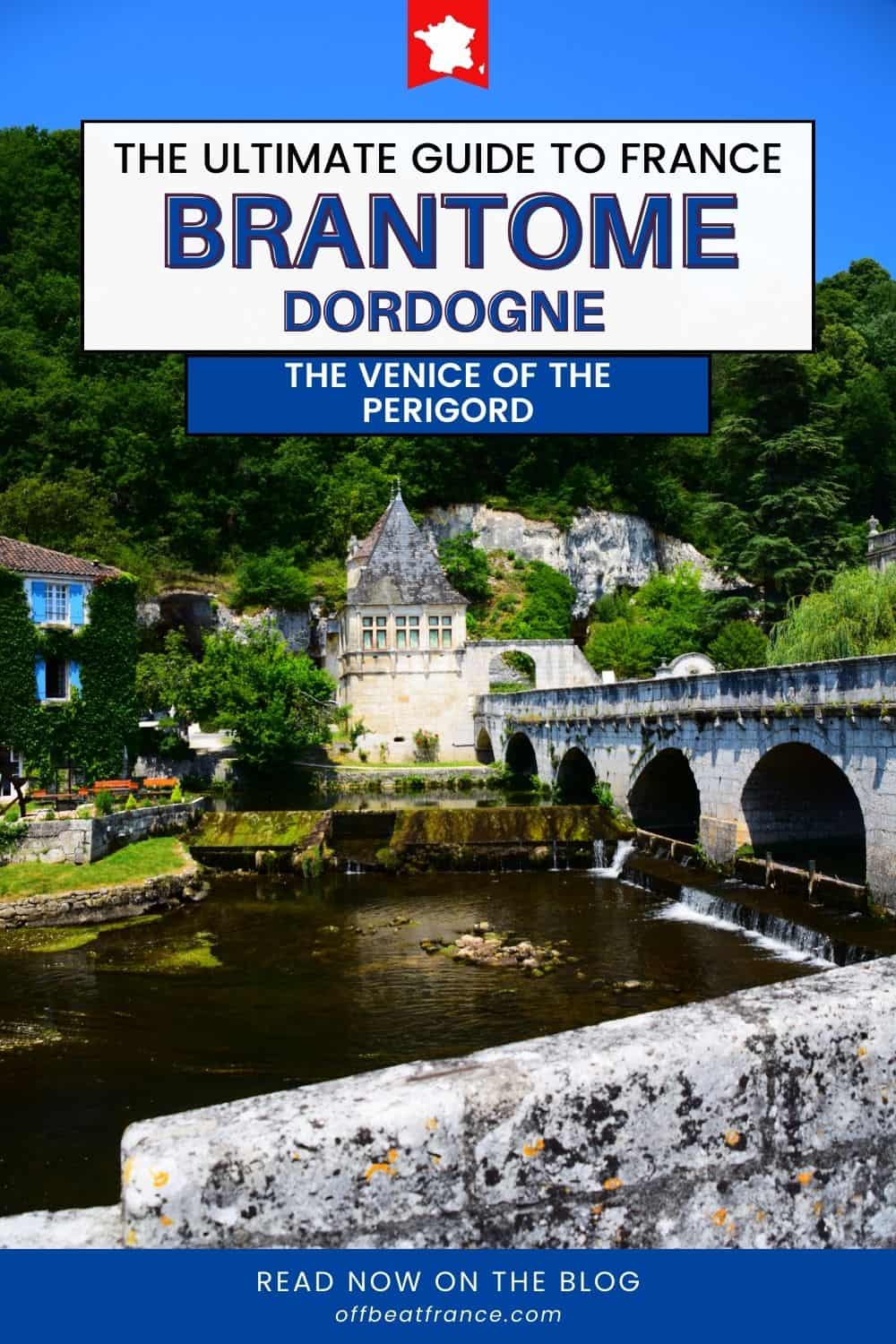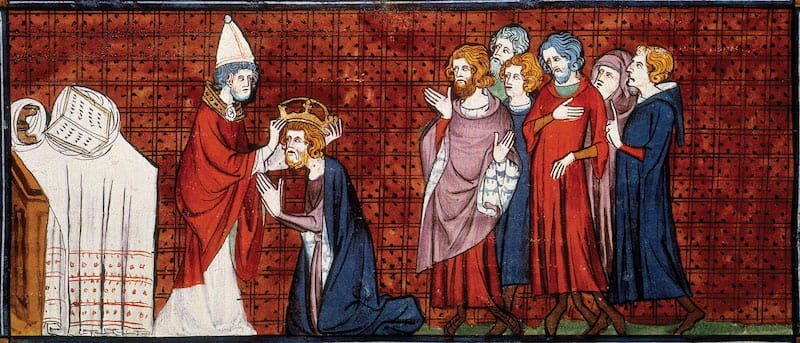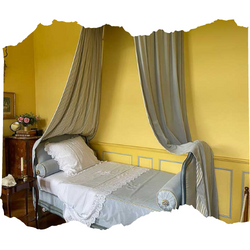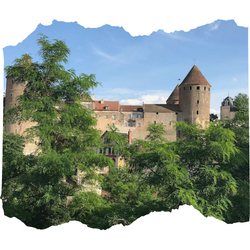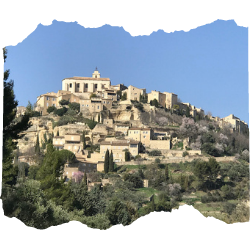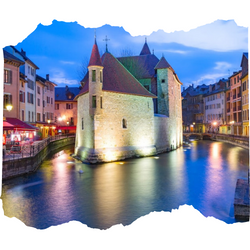Unsure about your French table manners? Click Here to download > > How to avoid these 10 food etiquette mistakes !
- Home ›
- Destinations ›
- Southwest France ›
- Brantome
Brantome, France: Venice of the Périgord
Published 9 January 2023 by Sabrina Maasdam*, Guest Contributor
Brantôme-en-Périgord, its full name, is known as one of the most beautiful and picturesque villages in the Périgord Vert region of the Dordogne. Here's a guide to what to do in Brantome.
Even in a land of picturesque villages and lush, hilly countryside, Brantôme stands out for its charm.
Known as “the Venice of the Perigord” − it is bisected by the River Dronne − Brantome is also known for its historical sites and its culinary specialties.
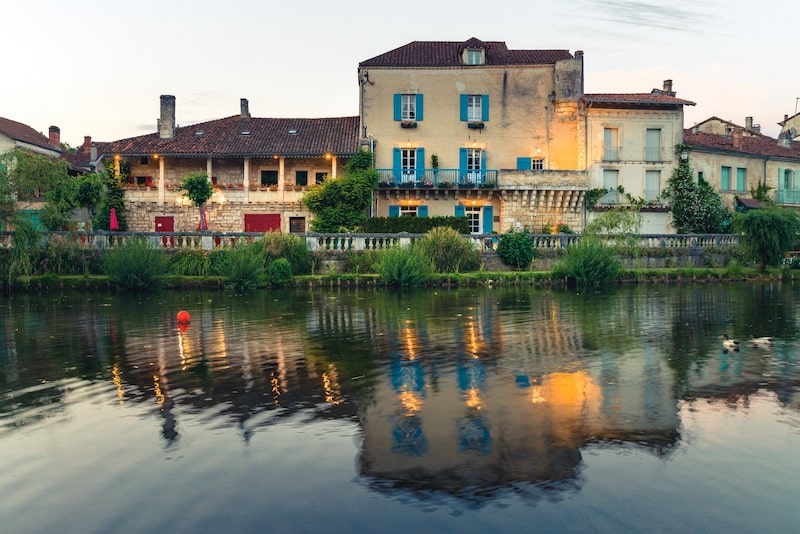 A bucolic view of Brantome from the river. Photo courtesy Le Moulin de l'Abbaye.
A bucolic view of Brantome from the river. Photo courtesy Le Moulin de l'Abbaye.NOTE: Pages on this site may contain affiliate links, which support this site. See full Privacy Policy here.
6 charming things to do in Brantome
Brantome is a small village and much of its charm will be enjoyed by simply walking around and soaking in the atmosphere. But there is plenty more to do.
1. Visit the abbey and the caves
Its history (see below) makes Brantome fascinating and the village's major landmark is of course the Abbey of Brantome, which is open all year round.
The caves which preceded the abbey are an important spiritual site and attract many pilgrims and hermits, even today.
The most impressive cave is the Grotto of the Last Judgement. Some people interpret the carvings as Jesus Christ judging the people, while others see scenes of death from the times of the Plague.
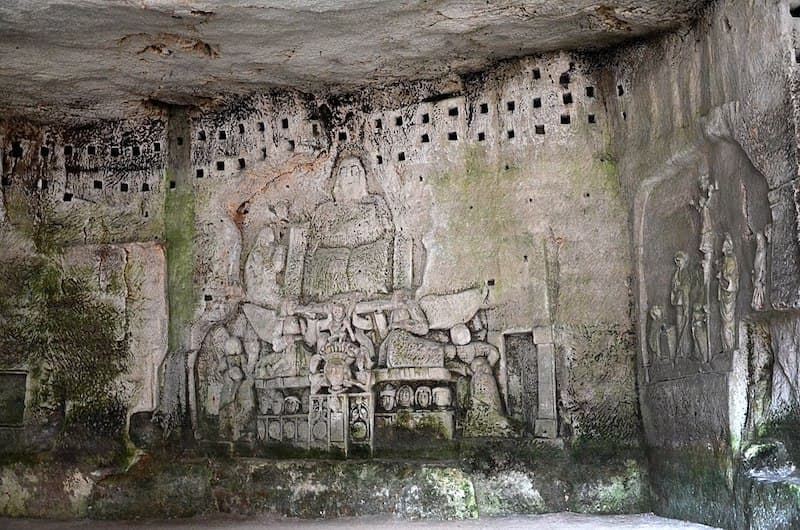 Lamiot, CC BY-SA 4.0, via Wikimedia Commons
Lamiot, CC BY-SA 4.0, via Wikimedia Commons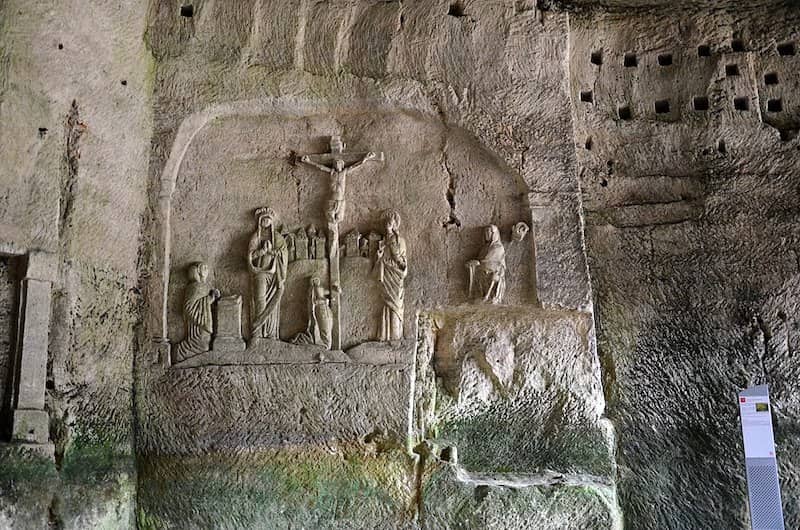 Top and bottom photos depict different views of the so-called Last Judgment grotto. Photos by Lamiot, CC BY-SA 4.0
Top and bottom photos depict different views of the so-called Last Judgment grotto. Photos by Lamiot, CC BY-SA 4.0The grottoes are now partly hidden by the abbey's more conventional buildings but you can still see the various living quarters once used by the monks.
While the abbey’s history is fascinating, take the time to look at it from the outside and catch its reflection on the water, one of the village’s favorite photography spots.
Combine your visit to the abbey with the Ferdinand Desmoulins Museum, located in the convent buildings. Fernand Demoulin was a famous academic and engraver.
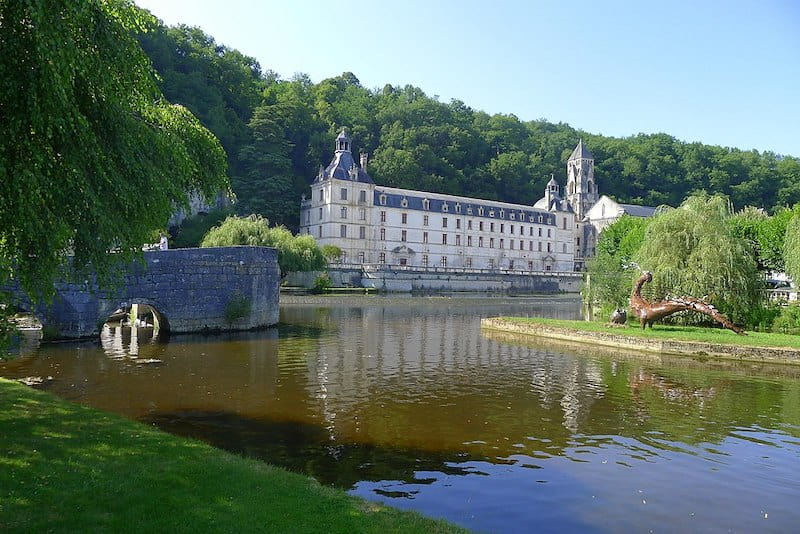 The Abbey of Brantome as seen from the river. Photo by Marmotteauxskis, CC BY-SA 4.0
The Abbey of Brantome as seen from the river. Photo by Marmotteauxskis, CC BY-SA 4.0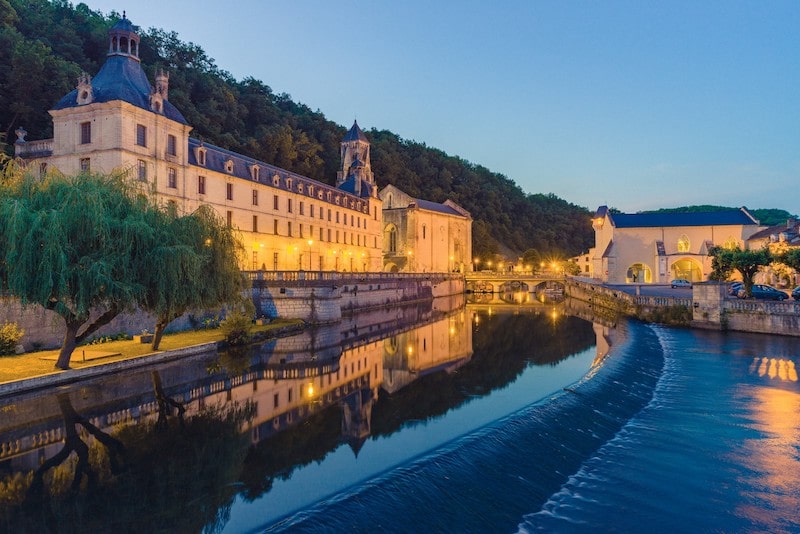 If anything, the Abbey is even more beautiful after sunset. Photo courtesy Le Moulin de l'Abbaye.
If anything, the Abbey is even more beautiful after sunset. Photo courtesy Le Moulin de l'Abbaye.2. Shop the market of Brantome
Few things are as delightful as a Dordogne village market and Brantome has two weekly markets, one on Tuesday and one on Friday mornings, throughout the town’s center, should you want to buy some local products here.
If you miss the market, you can still stock up on regional products, art and handmade crafts in one of the many small stores you’ll find in the village.
3. Canoe on the Dronne River
You can rent kayaks and canoes as well as stand-up paddles in Brantome and explore the picturesque village from one of its best viewpoints − the water.
4. Take a river cruise
If you love the water but would rather forgo water sports, why not take a cruise, either around Brantome or to other parts of the Périgord Vert? Cruises vary in length but some can go up to half a day and include a regional meal at a restaurant or farm.
5. Enjoy a glass-blowing show
Located in one of the caves near the abbey, Oscar Simonin’s artisan glass-blowing studio provides a fascinating glimpse into the world of traditional glass. The studio is called La Grotte Du Souffleur de Verre and you can watch the artist at work, enjoy his creations on exhibit, or buy some of his work.
6. Stroll around Les Jardins Tranquilles
The riverside gardens, also called Les Jardins Tranquilles, are a special gem of Brantome. They have been open to the public for over 30 years, and were originally called Les Jardins d'Au-Delà, the Gardens of Beyond.
The gardens were created by Jean-Pierre Texier, a passionate gardener. They are filled with impressive flowers, fountains, sculptures, and thousands of trees of a variety of specices, all over 12 acres of land. An ideal place for a picnic!
What is the history of Brantome?
Much of Brantome's history revolves around that of its Benedictine abbey. The Brantome abbey was founded in 769 by Charlemagne, the Frankish king known for having reunited Western Europe, which had splintered into factions after the fall of the Roman Empire.
According to the Gospel of St. Matthew, important historical relics of the Massacre of the Innocents were donated to the abbey, etching it into history. In fact, the abbey is dedicated to Saint Sicaire, one of the infants murdered by King Herod during the massacre after the birth of Jesus.
Over the years, the relics drew a steady stream of pilgrims to Brantome. People began to settle around the abbey, and the village − located on one of the routes of the Camino − expanded.
Like many religious buildings in France, the abbey was destroyed several times by war. It was rebuilt at the end of the 10th century and again in 1465 and 1480. In the first half of the 16th century, the abbot, Pierre de Bourdeille, built an intriguing right-angled bridge over the Dronne so that monks could cross over from the abbey to the garden on the other side.
There was a good reason for the odd shape: the bridge was built right where two opposing currents meet, that of the river and of the Monks’ Canal.
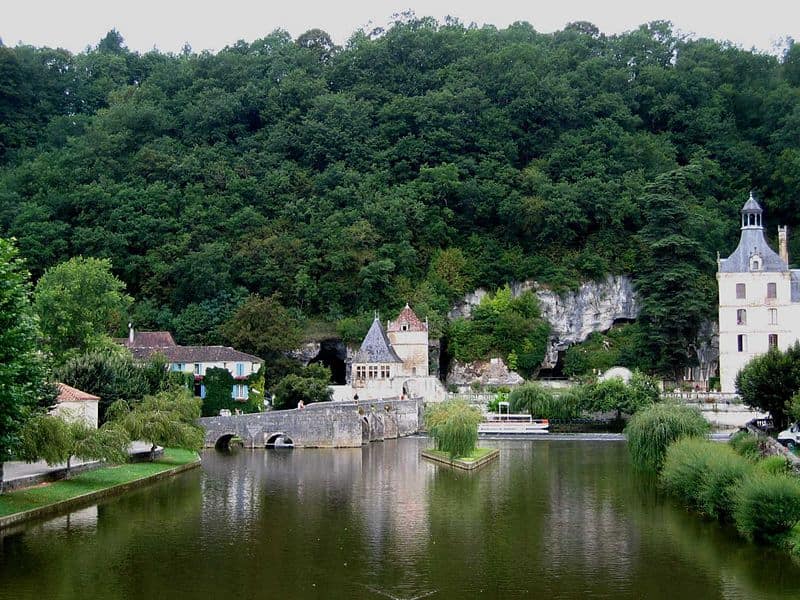 The Pont Coudé, or 'right-angled bridge'. Photo by Rene Boulay, CC BY-SA 3.0
The Pont Coudé, or 'right-angled bridge'. Photo by Rene Boulay, CC BY-SA 3.0PIERRE DE BOURDEILLE
Pierre de Bourdeille was a famous abbot for more than the bridge.
He was a great traveler, military man and writer before becoming abbot, but his greatest claim to fame was saving the commune and the abbey from the Huguenots during the Wars of Religion, twice.
Historians say he succeeded mainly because of his diplomatic skills: he threw open the abbey’s doors and welcomed the attacking Huguenots to a huge feast. They left without damaging anything.
But De Bourdeille had flirted with Protestantism, which may also have made Coligny, the Huguenot leader, more amenable to saving the abbey…
The oldest remaining part of the abbey is an 11th-century square tower and belfry – considered one of the oldest in France – overlooking the church. The church, however, contains remnants of the original troglodytic caves of the very first monastery, the one built under Charlemagne, some of which contain carvings and can still be visited.
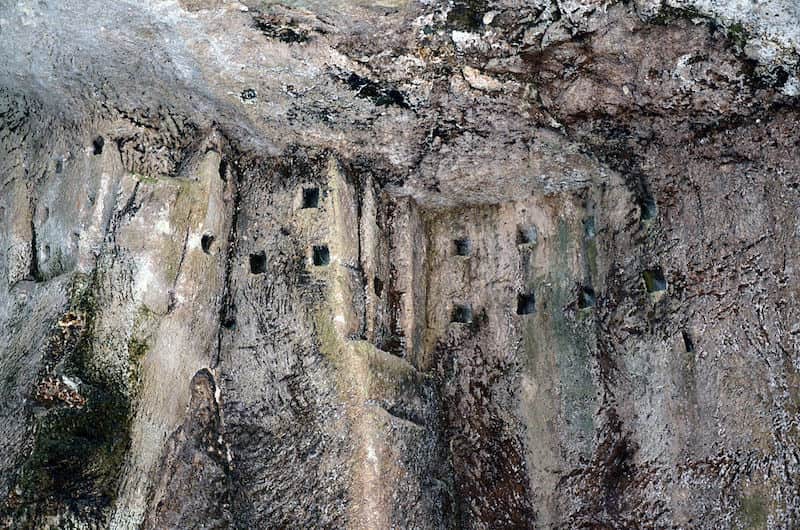 The caves contained monks' cells and pigeonholes, which can be seen here. Photo by Lamiot, CC BY-SA 4.0
The caves contained monks' cells and pigeonholes, which can be seen here. Photo by Lamiot, CC BY-SA 4.0Places to visit near Brantome
From Brantome you can visit other stunning sights, like the medieval château and fortress in Bourdeilles, only a few minutes away.
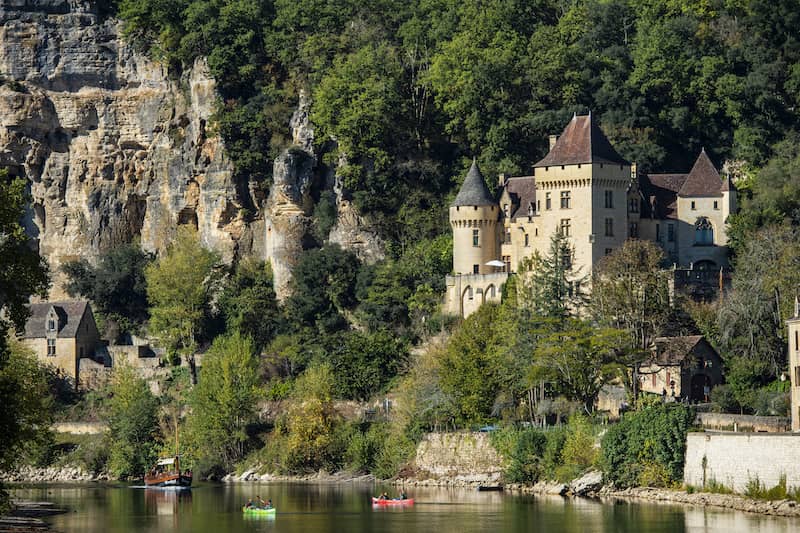 La Roque Gageac, one of the Dordogne's glorious villages
La Roque Gageac, one of the Dordogne's glorious villagesApart from Bourdeilles, La Roque Gageac and Aubeterre-Sur-Dronne are two delightful villages as picturesque as Brantome, but unique in their own way. La Roque Gageac is also built on the side of a hill and is famous for its Renaissance Chateau de la Malartrie, while Aubeterre is, among other things, famous for the underground Church of St Jean.
Lovers of wine will appreciate a trip to the nearby wine region of Libournais, Bordeaux. The charming village of Saint Emilion, a renowned UNESCO world heritage site, is worth a visit. Some of the best wines in France are made in the Libournais area. Many chateaux are open for visitors and offer great wine tastings and tours around the winery and the castles.
Eating in Brantôme
The Dordogne is known for its food and drink and has one of France's most impressive gastronomic heritages. Some people refer to the Dordogne as the capital of duck and truffle, and the region has many other regional products, like walnuts and asparagus.
The famous local truffles can be tasted in Brantome restaurants and bought on the Friday market.
A fabulous hotel-restaurant in Brantome is Le Moulin de l’Abbaye, the perfect hotel for a stylish stay in Brantome with an unbeatable river view – and you cannot get much closer to the abbey than this!
A member of the fabled Relais & Châteaux network, this delightful spot on the river is home to not one but two bistrots, and to crown it all, a Michelin-starred gastronomic restaurant which specializes in local products and cuisine, with a stylish and modern twist.
For those days when your appetite is lighter, head for one of the bistrots or just sit on the terrace, watching the river float by.
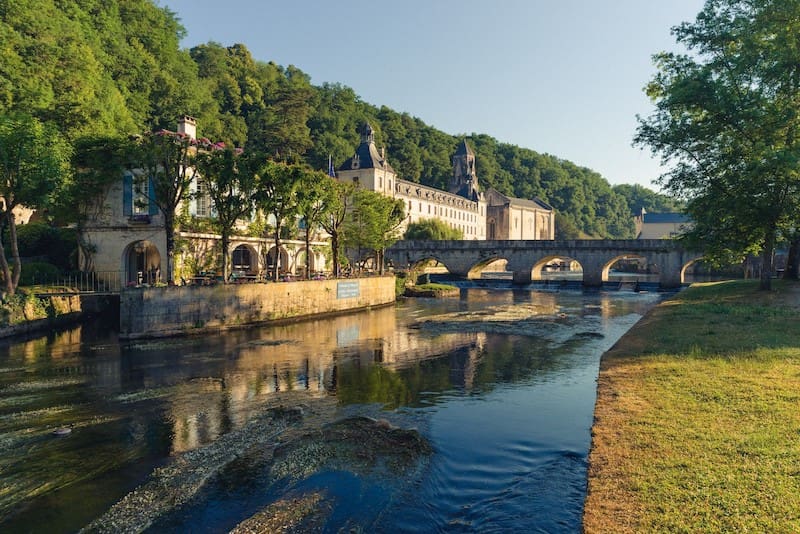
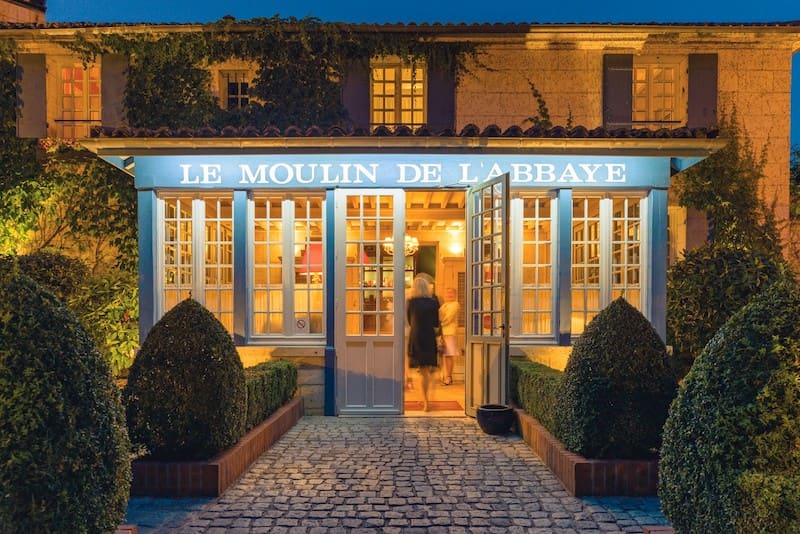 Top: the abbey, with the hotel-restaurant Moulin de l'Abbaye on the left. Bottom, the restaurant's welcoming entrance. Photos courtesy of Le Moulin de l'Abbaye.
Top: the abbey, with the hotel-restaurant Moulin de l'Abbaye on the left. Bottom, the restaurant's welcoming entrance. Photos courtesy of Le Moulin de l'Abbaye.For another enchanting dinner experience, head for the restaurant Charbonnel, part of the Hotel Charbonnel. Chef Sébastien Riou combines seasonal and organic products in a new and modern fashion to create a delightful experience.
The view from the terrace is special, overlooking the river Dronne with the fabulous abbey in the background. Check to see if they're hosting a repeat of their truffle-tasting experience, and enjoy their wine cellar with wines from more than 300 French vineyards.
How to get to Brantome
You can find Brantome in the Perigord Vert, just north of Périgueux. The village is easily reachable by car and there is parking available. There is no train station in Brantome, however, but you can get here by bus from Angoulême and Périgueux.
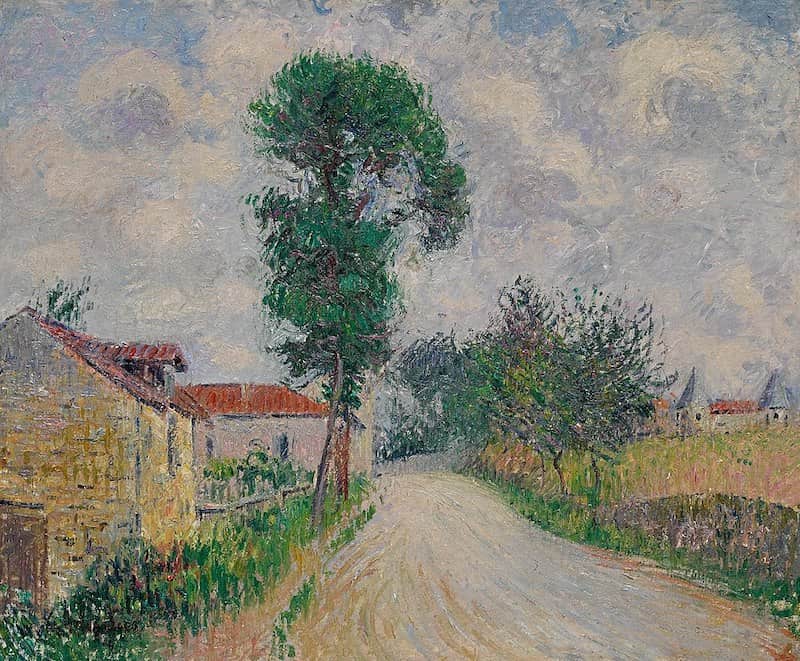 La Route de Brantôme à Périgueux, painted in 1920 by Gustave Loiseau, a French post-impressionist artist
La Route de Brantôme à Périgueux, painted in 1920 by Gustave Loiseau, a French post-impressionist artist*Sabrina Maasdam blogs about slow and luxury travel at Shades of Summer.
Brantome FAQ
Is Brantome worth visiting?
Only if you like adorable villages with great food, historical abbeys and lush gardens, all bordered by a romantic river.
What day is Brantome's market?
Brantome market day is Tuesday and Friday mornings.
Where is Brantome?
Brantome is in the Dordogne department, also known as the Périgord, its traditional designation. It is located in western France, in the "official region" of Nouvelle-Aquitaine.
Did you enjoy this article? I'd love if you shared it!
